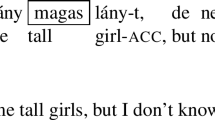Abstract
The paper treats VP-ellipsis data in Hungarian from the perspectiveof identity requirements between the elided and the anteceding V-form. Theexamination of the data yields the generalization that agreement marking apparentlyfalls under the notion of sloppy identity, while tense marking shows littlevariability. Nevertheless it is argued here that the licensing of ellipsisobserves the strict identity requirement: elided Agr is not only recoverablefrom the anteceding V-form in a parallel clause, but, more locally, from theanchor of agreement (subject, object). Likewise, the ellipsis of inffinitivalmarking can be locally licensed by relying on selectional properties. Theframework of the analyses is Distributed Morphology, a late insertion theory,whereby ellipsis is regarded neither as deletion, nor as reconstruction, butas non-insertion of phonological material at the level of morphology.
Similar content being viewed by others
References
Ackema, P. 1995. Syntax below zero. Doctoral dissertation, Utrecht University.
Baker, M. 1985. The Mirror Principle and morphosyntactic explanation. Linguistic Inquiry 16: 373–415.
Bartos, H. 1997. On “subjective” and “objective” agreement in Hungarian. Acta Linguistica Hungarica 44: 363–84.
Bartos, H. 2000. Az inflexiós jelenségek szintaktikai háttere [The syntactic aspects of inflec-tional phenomena]. In: Kiefer, F. (ed.): Strukturális magyar nyelvtan 3. Morfológia. [A structural grammar of Hungarian 3. Morphology], 653–762. Akadémiai Kiadó, Budapest.
Bródy, M. 1995. Focus and Checking Theory. In: Kenesei, I. (ed.): Approaches to Hungarian. Volume 5: Levels and structures, 29–41. JATE, Szeged.
Chomsky, N. 1995. The Minimalist Program. The MIT Press, Cambridge MA.
Fiengo, R.-May, R. 1994. Indices and identitiy. The MIT Press, Cambridge MA.
Grimshaw, J. 1991. Extended projection. Ms., Brandeis University.
Grimshaw, J. 1997. Projection, heads, and optimality. In: Linguistic Inquiry 28: 373–422.
Halle, M.-Marantz, A. 1993. Distributed morphology and the pieces of inflection. In: Hale, K.-Keyser, S.J. (eds): The view from Building 20. Essays in linguistics in honor of Sylvain Bromberger, 111–76. The MIT Press, Cambridge MA.
Hornstein, N. 1995. Logical Form. Blackwell, Oxford & Cambridge MA.
Kitagawa, Y. 1991. Copying identity. Natural Language and Linguistic Theory 9: 497–536.
Lasnik, H. 1995. Verbal morphology Syntactic structures meets the minimalist program. In: Campos, H.-Kempchinsky, P. (eds): Evolution and revolution in linguistic theory: essays in honor of Carlos Otero, 251–75. Georgetown University Press, Washington D.C.
Quirk, R.-Greenbaum, S.-Leech, G.-Svartvik, J. 1972. A grammar of contemporary English. Longman, London.
Sag, I. A. 1976. Deletion and Logical Form. Doctoral dissertation, MIT, Cambridge MA.
Szabolcsi, A. 1996. Verb and prefix movement in Hungarian. Ms., UCLA.
Author information
Authors and Affiliations
Rights and permissions
About this article
Cite this article
Bartos, H. VP-ellipsis and verbal inflection in Hungarian. Acta Linguistica Hungarica 47, 3–23 (2000). https://doi.org/10.1023/A:1014076329006
Issue Date:
DOI: https://doi.org/10.1023/A:1014076329006




